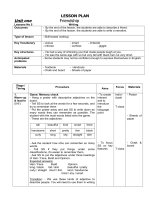unit 1 writing IELTS
Bạn đang xem bản rút gọn của tài liệu. Xem và tải ngay bản đầy đủ của tài liệu tại đây (216.59 KB, 14 trang )
Unit 1: Exercise 1
How much do you already know about IELTS Writing Task 1?
Are the following statements True or False? Choose the correct answers.
1. You should spend 40 minutes on Task 1.
o
True
o
False
2. You will be asked to describe a chart, table, map or diagram.
o
True
o
False
3. You should include your opinions in the report.
o
True
o
False
4. You should write at least 150 words.
o
True
o
False
5. You must include every detail given in the information in your answer.
o
True
o
False
Unit 1: Exercise 2
In IELTS Writing Task 1, you may be asked to describe a bar chart. The opening
paragraph should include the following information:
•
the type of chart or table
•
what the information is about
•
the date(s)
•
the place(s)
•
the unit(s) of measurement.
Look at the bar chart and the table. Sentences 1–4 are opening paragraphs taken
from four different reports. Read the paragraphs and decide if they contain all
the necessary information. Match the comments in the box with the paragraphs.
The bar chart and table show information about students from abroad studying
in four English-speaking countries in 2004 and 2012.
Summarise the information by selecting and reporting the main features, and
make comparisons where relevant.
1. The bar chart shows the number of foreign students studying in the USA, the UK,
Australia and Canada, while the table shows foreign students as a percentage of total student
numbers in the countries. ______________________________________________
2. The bar chart shows the number of foreign students studying in four English-speaking
countries in the years 2004 and 2012, while the table shows foreign students as a percentage
of total student numbers in the countries.
______________________________________________
3. The bar chart shows the number of foreign students studying in English-speaking countries
in 2004 and 2012, while the table shows foreign students as a percentage of total student
numbers in the countries. ______________________________________________
4. The bar chart and the table show the changes in foreign student numbers between 2004 and
2012 in the USA, the UK, Australia and Canada.
______________________________________________
Unit 1: Exercise 3
When describing charts and tables, we need to think about what information to
include and which paragraph to put the information in.
Choose the correct paragraph (A, B or C), for the statements (1–5).
A
The bar chart shows the number of foreign students studying in four English-speaking
countries in the years 2004 and 2012, while the table shows foreign students as a percentage
of total student numbers in the countries. We can see that the overall trend is an increase in
the number and percentage of international students in most countries.
B
Starting with the number of students, the USA had the most foreign students, rising from
approximately 179,000 in 2004 to around 245,000 in 2012. The figures for Australia and the
UK were similar, increasing from around 120,000 to almost 200,000. Canada had a
significantly lower number of overseas students than the other countries, with about 41,000 in
2004 and approximately 61,000 in 2012.
C
Next, if we look at foreign students as a percentage of total student numbers, we can see that
percentages increased for all countries, with the exception of the USA. The percentage of
foreign students was highest in Australia at 24% of total student numbers in 2012. In contrast,
in the USA, the percentage of foreign students remained stable at 2%, which was the lowest
percentage of all four countries.
This paragraph ...
1. gives a summary of the most important information. ______
2. tells us about the important data (percentage) changes shown in the table. ______
3. describes what the bar chart and table are about and what information they show.
______
4. includes the important data (numbers) from the bar chart. ______
5. tells us what type of chart is being described. ______
Unit 1: Exercise 4
In IELTS Writing Task 1, you need to decide what information is important. The
key information is:
•
the main trend
•
something which doesn’t follow a trend
•
highs, lows and equal points.
Look at the sentences from the essay and choose the correct answers. More than
one answer may be possible.
1. The USA had the highest number of foreign students.
the main trend
something which doesn’t follow a trend
highs, lows and equal points
2. Canada had significantly lower student numbers than the other countries with
around 41,000 in 2004 and approximately 61,000 in 2012.
the main trend
something which doesn’t follow a trend
highs, lows and equal points
3. However, in the USA, the percentage of foreign students remained the same.
the main trend
something which doesn’t follow a trend
highs, lows and equal points
4. There was an increase in both the number, and percentage, of international students
in all but one of the countries.
the main trend
something which doesn’t follow a trend
highs, lows and equal points
5. Foreign students, as a percentage of total student numbers, was highest in Australia
and lowest in the USA.
the main trend
something which doesn’t follow a trend
highs, lows and equal points
Unit 1: Exercise 5
Look at the bar chart and table. Then read the statements and decide if they
contain key information or not. Choose Yes or No.
1. The USA had the highest number of foreign students. Yes/No
2. In Canada, foreign students, as a percentage of total student numbers, rose between
2004 and 2012. Yes/No
3. The number of students increased in all the countries. Yes/No
4. The UK had the second lowest percentage of foreign students as a percentage of total
student numbers in 2004. Yes/No
5. However, in the USA, overseas students, as a percentage of total student numbers,
remained the same. Yes/No
6. The number of foreign students in Canada was much lower than in the other
countries. Yes/No
7. Foreign students, as a percentage of total student numbers, in Canada in 2012, was the
second highest. Yes/No
8. The numbers of foreign students in the UK and Australia were very similar. Yes/No
Unit 1: Exercise 6
Look at the bar chart and table. Then read the statements and decide if they are
True or False.
1. The UK had the second highest number of foreign students in both years.
o True
o False
2. The number of foreign students in Canada rose by just under 50%.
o True
o False
3. There were over 80,000 more foreign students in the UK in 2012 than in 2004.
o True
o False
4. In the USA, foreign students, as a percentage of total student numbers, fell during the
period.
o True
o False
5. In Australia, foreign students, as a percentage of total student numbers, was the
highest of all countries in both years.
o True
o False
6. In Canada, foreign students, as a percentage of total student numbers, was the
lowest in both years.
o True
o False
7. There were nearly 300,000 foreign students in the USA in 2012.
o True
o False
8. The rise in student numbers in the UK was approximately four times greater than in
Canada.
o True
o False
Unit 1: Exercise 7
It is important that you support the information with accurate numbers (data)
when completing IELTS Writing Task 1.
Look at the bar chart and table. Then put the numbers in the correct gaps to
complete the sentences.
120,000
2
24
245,000
61,000
1. The USA had the most foreign students, rising from approximately 179,000 in 2004 to around
___________ in 2012.
2. The percentage of foreign students in the USA was lowest of all countries during both years, at
____________ %
3. The percentage of foreign students was highest in Australia at ______________ % of total student
numbers in 2012.
4. Canada had the lowest number of overseas students in both years, with 41,000 in 2004 and
approximately ___________ in 2012.
5. Student numbers in Australia and the UK were similar in 2004, at around ___________ .
Unit 1: Exercise 8
Look at the bar chart and table. Then complete the report with the correct
numbers in the box (some numbers you can use more than once).
2%
200,000
2004
2012
41,000
The bar chart shows the number of foreign students studying in four English-speaking
countries in the years _____________ and _____________ , while the table shows foreign
students as a percentage of total student numbers in the countries. We can see that the overall
trend is an increase in both the number and percentage of international students in most
countries.
Starting with the number of students, the USA had the most foreign students, rising from
approximately 179,000 in ____________ to around 245,000 in _____________ . The figures
for Australia and the UK were similar, increasing from around 120,000 to almost
_________________ . Canada had a significantly lower number of overseas students than
the other countries, with about _____________ in 2004 and approximately 61,000 in 2012.
Next, if we look at the percentage of foreign students, we can see that percentages increased
for all countries, with the exception of the USA. The percentage of foreign students was
highest in Australia at 24% of total student numbers in 2012. In the USA, the percentage of
foreign students remained stable at _______________ , which was the lowest percentage of
all four countries.
Unit 1: Exercise 9
Look at the IELTS Writing Task 1 question.
The chart gives information on the percentage of women going into higher education in
five countries for the years 1970 and 2005.
Summarise the information by selecting and reporting the main features, and make
comparisons where relevant.
Then read the statements below and decide which points need to be included in your report.
Choose the correct answers.
1. The UK figure was 60% in 2005.
o Yes
o No
2. In Germany, the percentage increased from 50% to 55%.
o Yes
o No
3. The percentage of women studying in the UK rose from approximately 35% to 60%.
o Yes
o No
4. The overall proportion of women in higher education increased in all five countries.
o Yes
o No
5. The percentage of women studying in higher education in Japan doubled.
o Yes
o No
6. The percentage of women studying in the USA rose from 40% to 55%.
o Yes
o No
7. In 2005, 40% of female school-leavers didn’t go into higher education in Canada.
o Yes
o No
8. Changes were a result of wider social changes.
o Yes
o No
9. Canada’s percentage was the same in both years.
o Yes
o No
10. Canada had the highest percentage in both years.
o Yes
o No
Unit 1: Exercise 10
WRITING TASK 1
You should spend about 20 minutes on this task.
The chart gives information on the percentage of women going into higher education in
five countries for the years 1970 and 2005.
Summarise the information by selecting and reporting the main features, and make
comparisons where relevant.
Write at least 150 words.
Please add text into the Student post.
Student post:









